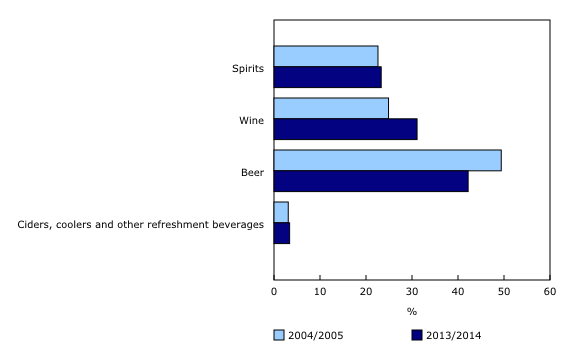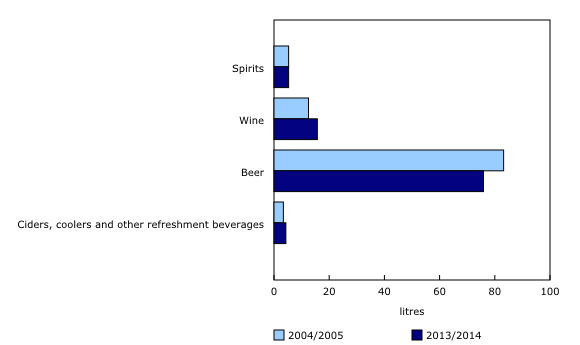Control and sale of alcoholic beverages, for the year ending March 31, 2014
Archived Content
Information identified as archived is provided for reference, research or recordkeeping purposes. It is not subject to the Government of Canada Web Standards and has not been altered or updated since it was archived. Please "contact us" to request a format other than those available.
Released: 2015-05-04
Liquor stores, agencies and other retail outlets sold $20.5 billion worth of alcoholic beverages during the fiscal year ending March 31, 2014, up 1.1% from the previous year. Beer remained the alcoholic drink of choice for Canadians, with $8.7 billion in sales, but the market share of other alcoholic beverages continued to grow.
The overall increase in alcoholic beverage sales slowed to 1.1% in 2013/2014, compared with a 2.2% gain the previous year. The growth rate in the value of ciders, coolers and other refreshment beverage sales (+9.5%) outpaced that of wine (+2.3%), spirits (+0.5%) and beer (0.0%). The overall volume of alcohol sold was 0.6% lower than a year earlier.
The net income realized by provincial and territorial liquor authorities increased 0.4% from a year earlier to $5.5 billion in 2013/2014. Most provinces and territories posted increases in net income. The annual average growth rate in net income of liquor authorities over the past decade was 4.2%.
Net income and other government revenue derived from the control and sale of alcoholic beverages, including excise taxes, retail sales taxes, specific taxes on alcohol as well as licence and permit revenues, were $10.5 billion in 2013/2014.
Market share of beer on the decline
Liquor stores, agencies and other retail outlets sold $8.7 billion worth of beer during the fiscal year ending March 31, 2014, essentially unchanged from the previous year. Canadian beer sales decreased by 0.6%, while imported beer sales increased by 3.3%.
Among the provinces and territories, beer sales had the greatest market share in Nunavut at 57% of total sales of alcoholic beverages and the lowest in British Columbia at 37%. Alberta (+5.2%) reported the largest sales increase, while Nunavut (-6.8%) posted the largest decline.
The average annual growth rate of beer sales over the past 10 years was 1.5%. Canadian beer sales grew at an annual average rate of 0.9% over the past decade, while imported beer sales grew on average by 5.5% annually.
Beer sales as a share of the total sale of alcoholic beverages have been declining for several years. In 2004/2005, beer had a market share of 49% in terms of dollar value, while wine had a market share of 25%. By 2013/2014, the market share for beer had declined to 42%, while wine had increased its share to 31%.
In terms of volume, liquor stores, agencies and other retail outlets sold 2.2 billion litres of beer in 2013/2014. The volume of Canadian beer sold decreased 1.9% from a year earlier to 1 920.1 million litres, while imported beer sold edged up 0.7% to 317.5 million litres.
The average annual growth rate of beer sales over the last decade (in volume) was 0.3%. Imported beer sales grew at an annual average rate of 4.0%, while Canadian beer sales decreased at an annual average rate of 0.2%.
On a per-capita basis, beer sales totalled 75.9 litres or $294 in the fiscal period ending March 31, 2014, compared with 83.2 litres per person a decade earlier (in the fiscal period ending March 31, 2005).
Wine's popularity continues to grow
Liquor stores, agencies and other retail outlets sold $6.4 billion worth of wine during the year ending March 31, 2014, up 2.3% from the previous year. Every province and territory reported gains, with Newfoundland and Labrador (+9.1%) posting the highest growth, followed by Saskatchewan (+6.4%).
Among the provinces and territories, wine sales had the greatest market share in Quebec (43%) of total sales of alcoholic beverages and the lowest in Nunavut (12%). The average annual growth rate of wine sales over the past 10 years was 5.9%. Canadian wine sales grew at an annual average rate of 5.4% over the last decade, while imported wine sales grew by 6.1% annually.
In terms of volume, wine sales increased 1.0% from a year earlier to 461.7 million litres in 2013/2014. The growth in volume of imported wine (+1.1%) outpaced that of Canadian wine (+0.8%). The average annual growth rate of wine sales over the last 10 years (in volume) was 3.9%. Canadian wine sales grew at an annual average rate of 3.3% over the past decade, while imported wine sales grew by 4.2% annually.
The share of imported red wine sales was virtually unchanged over the past 10 years, accounting for 77% of all red wines sold in 2013/2014 compared with 76% in 2004/2005. Over the same period, the market share of imported white wine sales increased from 57% to 61%.
On a per-capita basis, wine sales amounted to 15.7 litres or $216 in 2013/2014, an increase of 3.2 litres per person from 2004/2005.
Spirit sales slow down
Liquor stores, agencies and other retail outlets sold $4.8 billion worth of spirits during the year ending March 31, 2014, up 0.5% from the previous year. Among the provinces and territories, spirit sales had the greatest market share in the Northwest Territories (41%) of total sales of alcoholic beverages, and the lowest in Quebec (13%).
Canadian spirit sales decreased 1.1%, while imported spirit sales increased 2.4%. Gin sales grew at the greatest rate (+2.9%), followed by whisky (+2.3%) sales. Liqueur sales (-2.0%) saw the largest drop.
The average annual growth rate of spirit sales over the last 10 years was 3.7%. Canadian spirit sales grew at an annual average rate of 2.1% over the past decade, compared with an annual average growth rate of 5.8% for imported spirits.
In terms of volume, the amount of spirits sold fell 1.6% in 2013/2014 to 157.7 million litres. Sales of Canadian spirits totalled 91.5 million litres, down 3.0% in 2013/2014, while the volume of imported spirits sales increased by 0.3% to 66.1 million litres. Imports accounted for more than 40% of the market share of spirits in Canada.
Imports of spirits have been rising for several years, increasing from 35.1% of spirits sold in 2004/2005 to 41.9% in 2013/2014. The average annual growth rate of spirit sales (by volume) over the last 10 years was 1.5%. Canadian spirit sales grew at an annual average rate of 0.2% over the past decade, while imported spirits sales grew by 3.5% annually.
On a per-capita basis, spirits sales amounted to 5.3 litres ($163) in 2013/2014, unchanged from 2004/2005. The market share of spirits was 23.3% in 2013/2014, compared with 22.6% in 2004/2005.
Ciders, coolers, and other refreshment beverages: Small market share but with sustained and dynamic growth
Liquor stores, agencies, and other retail outlets sold $692.9 million worth of ciders, coolers, and other refreshment beverages (CCORB) in 2013/2014, up 9.5% from the previous year.
Among the provinces and territories, CCORB sales had the greatest market share in Saskatchewan (6.5%) of total sales of alcoholic beverages and the lowest share in Quebec (1.3%). Sales in Saskatchewan (+22.5%) and Alberta (+21.2%) had the highest growth rates.
The average annual growth rate of CCORB sales over the last 10 years was 4.2%. Canadian CCORB sales grew at an annual average rate of 1.7% while imported CCORB sales increased at an annual average rate of 14.3%.
In terms of volume, liquor stores, agencies and other retail outlets sold 127 million litres of CCORB in 2013/2014, up 12.1% from a year earlier. The average annual growth rate of CCORB sales over the last 10 years was 4.1%. Canadian CCORB sales grew at an annual average rate of 1.5%, while imported CCORB sales increased at an annual average rate of 15.9%.
On a per-capita basis, CCORB sales amounted to 4.3 litres or $24 in 2013/2014, compared with 3.4 litres per person in 2004/2005.
Note to readers
Updates to the questionnaire and CANSIM series in 2015
In 2015, the Control and Sale of Alcoholic Beverages program questionnaire, the "Government Liquor Authority: Report of Operations," was updated after conducting qualitative testing involving field interviews with provincial and territorial liquor authorities. Subsequently, new CANSIM tables were created to reflect the increased information brought about by this program change.
A fourth beverage category was added to the questionnaire—ciders, coolers, and other refreshment beverages (CCORB). International organizations including the World Health Organization publish alcohol statistics with four beverage categories: spirits, wine, beer, and other. Prior to the 2015 update, ciders and wine coolers were included with wines; spirit coolers were included with spirits; and beer coolers were included with beer. Other refreshment beverages not elsewhere classified could be reported as a spirit, wine, or beer, at the discretion of the respondent.
To improve the comparability of these statistics, the fourth beverage category, CCORB, was added to the questionnaire and to its associated CANSIM series. As of fiscal year ending March 31, 2014, most liquor authorities in Canada report sales using a variant of the fourth category that includes ciders, coolers, "ready-to-drink" beverages and/or other refreshment beverages.
To improve the comparability of the number and types of retail outlets between each province and territory's diverse alcohol beverage distribution networks, the categorization of outlets section was updated.
The tax and other government revenue sections of the questionnaire and associated CANSIM series were updated to include all retail sales taxes, excise taxes, specific taxes on alcohol, and other reported and identifiable government revenues derived from the control and sale of alcoholic beverages. Additionally, the sales figures in all CANSIM series were revised to show the pre-tax sales. Previously, the goods and services tax was included in the sales figures but other taxes were not.
Comparability and limitations of the data
Statistics on sales of alcoholic beverages by volume should not be equated with data on consumption. Sales volumes include only sales as reported by the liquor authorities and their agencies, including sales by wineries, breweries, and other outlets that operate under license from the liquor authorities. Consumption of alcoholic beverages would include all of these sales, as well as any unreported volumes of alcohol sold through ferment-on-premise operations or other outlets, and any unrecorded or illegal transactions.
Statistics on sales of alcoholic beverages by dollar value should not be equated with consumer expenditures on alcoholic beverages. Sales data refer to the revenues received by liquor authorities and their agents, and a portion of these revenues include sales to licensed establishments such as bars and restaurants.
The value of sales of alcoholic beverages excludes all sales taxes, the value of returnable containers, and deposits. Per capita sales by value and volume are based on the population aged 15 years and older. This is in accordance with the practice of Health Canada in presenting trends that are more realistic in the consumption of alcoholic beverages. This allows comparability with other countries, the Organisation of Economic Co-operation and Development and the World Health Organisation as they also present alcohol per capita data using the population aged 15 years and older.
The population estimates are based on CANSIM table 051-0001. Absolute volume of sales of alcoholic beverages is calculated by multiplying the sales volume by the percentage of alcohol content for each product category.
Contact information
For more information, or to enquire about the concepts, methods or data quality of this release, contact us (toll-free 1-800-263-1136; 514-283-8300; infostats@statcan.gc.ca) or Media Relations (613-951-4636; statcan.mediahotline-ligneinfomedias.statcan@canada.ca).
- Date modified:



